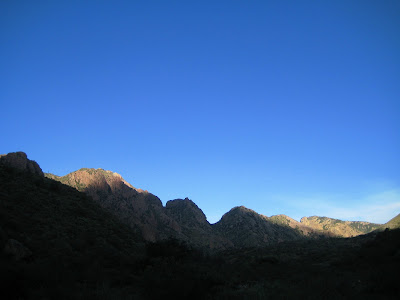
Texas, at least to a northerner, is a surprisingly diverse state, both in landscape and people. An eight hour drive through hill country, limestone mesas, and desert will drive this home. The last piece of road, south from I-10 to the park entrance, appears insignificant on the map, but it turns out to be over a hundred miles.
 To migrate through such a landscape must be terrifying. As we descended into the slightest of valleys, I thought of how desperate some must be for water, only to arrive at the dusty etchings of stream channels which only see water in floods. Average rainfall doesn’t matter down here; it all comes at once.
To migrate through such a landscape must be terrifying. As we descended into the slightest of valleys, I thought of how desperate some must be for water, only to arrive at the dusty etchings of stream channels which only see water in floods. Average rainfall doesn’t matter down here; it all comes at once. The Chisos Mountains, our destination, are in the center of the park, surrounded by desert on all sides, with the Rio Grande about 10 miles to the south. Given that one almost never hears about Texan mountains, they are surprisingly high and rugged, at 7500 feet in their highest point. Cliffs are everywhere. On the second day, we hiked Emory Peak, the tallest point,
 and walked out to the South Rim, a dramatic cliff escarpment stretching for several miles and dropping several thousand feet. The Rio Grande is a silver thread in the distance, shimmering all the more for the dusky air.
and walked out to the South Rim, a dramatic cliff escarpment stretching for several miles and dropping several thousand feet. The Rio Grande is a silver thread in the distance, shimmering all the more for the dusky air. I was astounded by the park’s haze. Parts of West Texas are supposed to have the clearest air in the lower 48—UT has an enormous observatory by Fort Davis—but our views were just as polluted as those in the Whites. Big Bend is the most isolated National Park south of Alaska, but it might as well be in the megalopolis as far as I could see. Mexican factories are the culprits, but their goods are made for Americans.

Flora and fauna change as one ascends in the mountains, much to my relief. In fact, West Texas is known for its mountain “island ecosystems,” caused by the cold air and orographic precipitation. Several species of tree are peculiar to the Chisos, and the number and variety of birds of prey is astounding. Best of all, I got to wear pants in the evening.
We camped in the Chisos Basin, surrounded by the high peaks (the place names—Juniper Canyon, the Elephant Tusk, Laguna
 Meadow—are wonderfully evocative). There is only one outlet to this enormous bowl, which goes to show how dry it is. Water flows down through the Window, a dramatic gap in the basin walls, and spills over a 200-foot cliff to the desert below. I had to take the guidebook’s word for it, though, because the rock has been worn so smooth that it’s slick as marble.
Meadow—are wonderfully evocative). There is only one outlet to this enormous bowl, which goes to show how dry it is. Water flows down through the Window, a dramatic gap in the basin walls, and spills over a 200-foot cliff to the desert below. I had to take the guidebook’s word for it, though, because the rock has been worn so smooth that it’s slick as marble. Future trips will involve exploration of the broken desert country and canyons along the Rio Grande. I am also curious to read more about John Joel Glanton, the bloodthirsty soldier and outlaw of Cormac McCarthy’s book Blood Meridian, whose real-life savagery still appalls. The park’s human history is limited but fascinating—fertile ground for future posts.

No comments:
Post a Comment